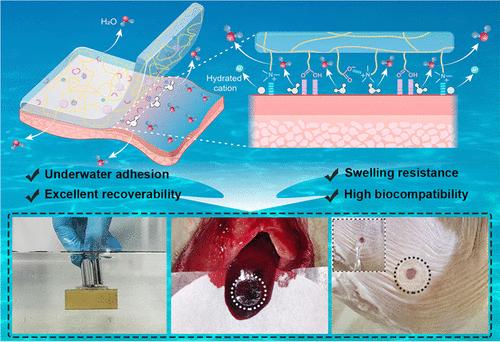当前位置:
X-MOL 学术
›
Chem. Mater.
›
论文详情
Our official English website, www.x-mol.net, welcomes your
feedback! (Note: you will need to create a separate account there.)
Poly(acrylic acid)-Derived Zwitterionic Hydrogel Unlocking Underwater Adhesion and Swelling Resistance for Applications as a Tissue Patch
Chemistry of Materials ( IF 7.2 ) Pub Date : 2024-10-31 , DOI: 10.1021/acs.chemmater.4c02562 Pengfei Li, Jinsong Yi, Ruilin Lu, Mou Wang, Xiaoming Liao, Yangyang Cheng, Shiyong Zhang
Chemistry of Materials ( IF 7.2 ) Pub Date : 2024-10-31 , DOI: 10.1021/acs.chemmater.4c02562 Pengfei Li, Jinsong Yi, Ruilin Lu, Mou Wang, Xiaoming Liao, Yangyang Cheng, Shiyong Zhang

|
Adhesive hydrogels, capable of autonomously adhering to tissues, offer substantial promise for biomedical applications. However, their practical utility is often constrained by challenges and potential failures in underwater adhesion, owing to the weakened interfacial interactions caused by the surface hydration layer and structural swelling-induced degradation of adhesive performance. To tackle this, we developed herein a polyzwitterionic hydrogel with underwater adhesion to several substrates, particularly biological tissues. This hydrogel, termed PAA@QAC(20/1), represents a hybrid poly(acrylic acid (AA)) (PAA)-based polymer incorporating interspersed quaternary ammonium cation (QAC) units, which retains and further surpasses the performance of traditional PAA hydrogels. QAC units can mimic the cationic amino acid residues in mussel foot proteins (Mfps) by replacing water molecules and hydrated cations in the hydration layer, allowing hydrogels to adhere firmly to the surface through electrostatic and hydrogen-bond interactions. Additionally, internal electrostatic cross-linking between AA and QAC enhances the phase separation-induced hydrophobicity, enabling hydrogel to maintain its adhesive properties without swelling. These unique characteristics endow PAA@QAC(20/1) with direct and durable adhesion to a series of biological tissues in the presence of blood or fluids, making it a promising material for a wide range of adhesive-involved biomedical applications.
中文翻译:

聚(丙烯酸)衍生的两性离子水凝胶可释放水下粘附性和抗溶胀性,可用作组织贴剂
粘性水凝胶能够自主粘附在组织上,为生物医学应用提供了巨大的前景。然而,由于表面水合层和结构溶胀引起的胶粘剂性能下降导致界面相互作用减弱,它们的实际效用往往受到水下粘合挑战和潜在失败的限制。为了解决这个问题,我们在这里开发了一种聚两性离子水凝胶,其水下粘附于多种基材,特别是生物组织。这种水凝胶被称为 PAA@QAC(20/1),代表了一种基于杂化聚丙烯酸 (AA)) (PAA) 的聚合物,其中包含散布的季铵盐离子 (QAC) 单元,它保留并进一步超越了传统 PAA 水凝胶的性能。QAC 装置可以通过替换水合层中的水分子和水合阳离子来模拟贻贝足蛋白 (Mfps) 中的阳离子氨基酸残基,使水凝胶通过静电和氢键相互作用牢固地粘附在表面。此外,AA 和 QAC 之间的内部静电交联增强了相分离诱导的疏水性,使水凝胶能够保持其粘合性能而不会膨胀。这些独特的特性使 PAA@QAC(20/1) 在血液或液体存在下对一系列生物组织具有直接和持久的粘附力,使其成为广泛涉及粘合剂的生物医学应用的有前途的材料。
更新日期:2024-10-31
中文翻译:

聚(丙烯酸)衍生的两性离子水凝胶可释放水下粘附性和抗溶胀性,可用作组织贴剂
粘性水凝胶能够自主粘附在组织上,为生物医学应用提供了巨大的前景。然而,由于表面水合层和结构溶胀引起的胶粘剂性能下降导致界面相互作用减弱,它们的实际效用往往受到水下粘合挑战和潜在失败的限制。为了解决这个问题,我们在这里开发了一种聚两性离子水凝胶,其水下粘附于多种基材,特别是生物组织。这种水凝胶被称为 PAA@QAC(20/1),代表了一种基于杂化聚丙烯酸 (AA)) (PAA) 的聚合物,其中包含散布的季铵盐离子 (QAC) 单元,它保留并进一步超越了传统 PAA 水凝胶的性能。QAC 装置可以通过替换水合层中的水分子和水合阳离子来模拟贻贝足蛋白 (Mfps) 中的阳离子氨基酸残基,使水凝胶通过静电和氢键相互作用牢固地粘附在表面。此外,AA 和 QAC 之间的内部静电交联增强了相分离诱导的疏水性,使水凝胶能够保持其粘合性能而不会膨胀。这些独特的特性使 PAA@QAC(20/1) 在血液或液体存在下对一系列生物组织具有直接和持久的粘附力,使其成为广泛涉及粘合剂的生物医学应用的有前途的材料。


















































 京公网安备 11010802027423号
京公网安备 11010802027423号